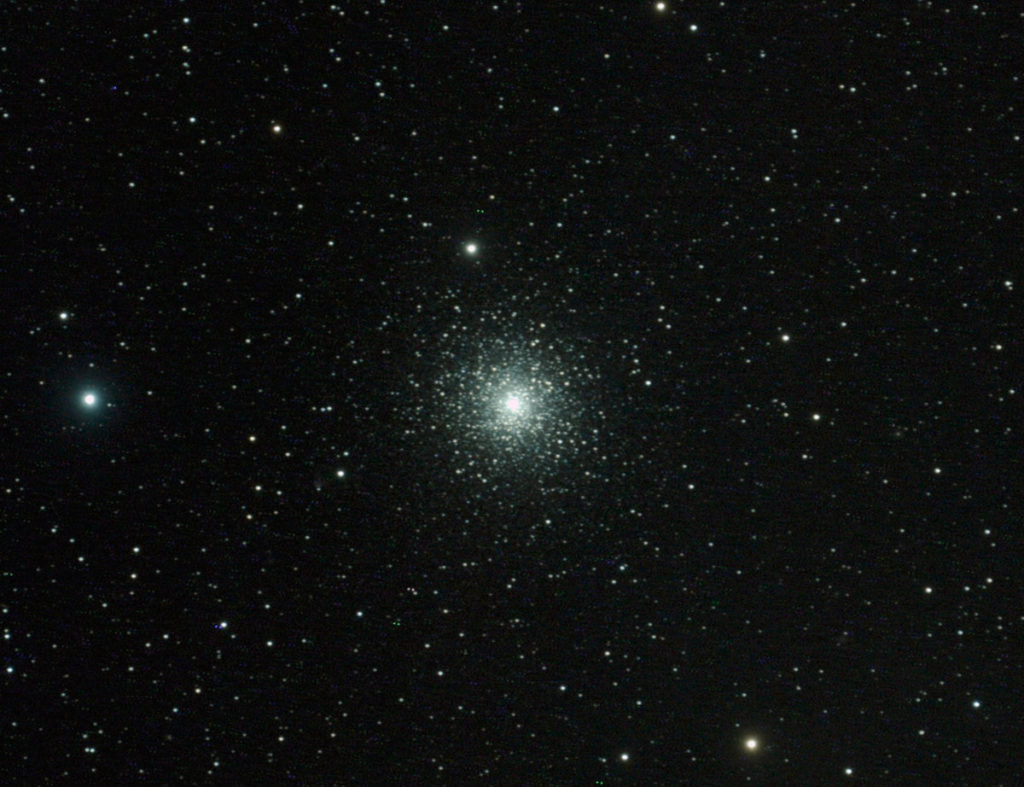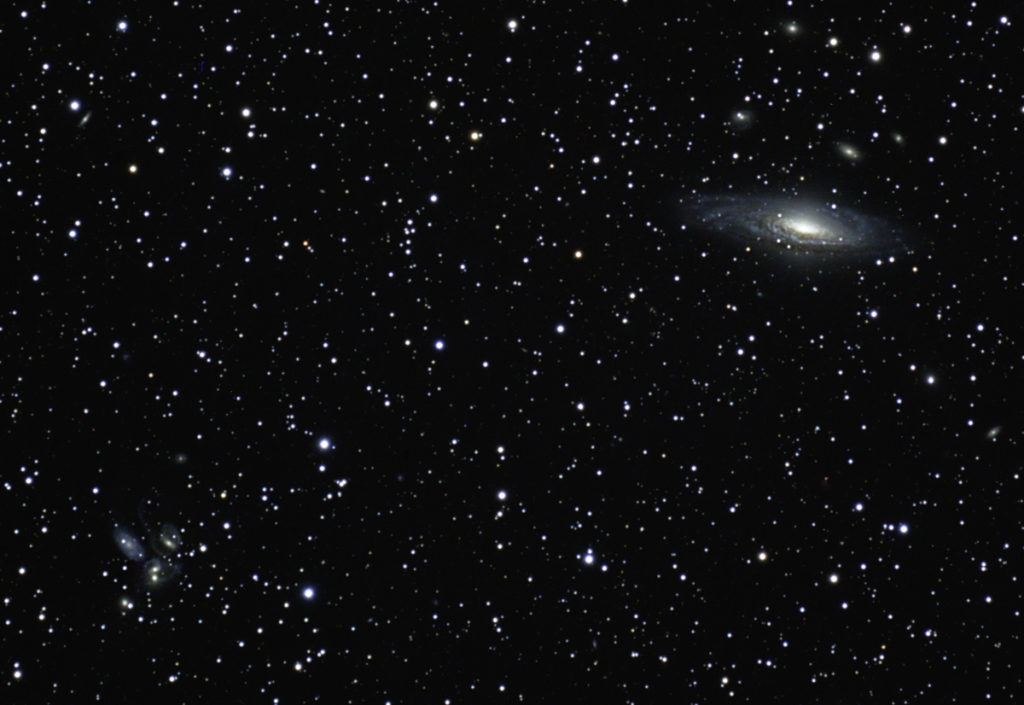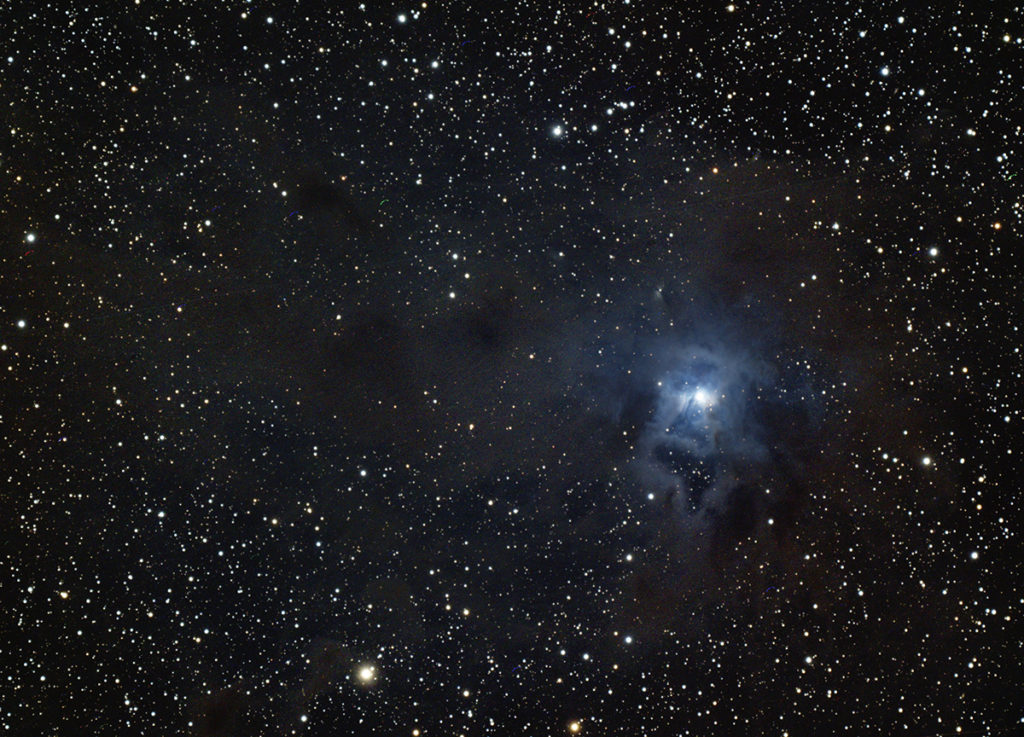
Image credit: Joe Bergeron.
I write this in late October. Every night, the sky is four minutes more wintry than it was the night before. For now, the sky is still dominated by the constellations most associated with Autumn, even as the Summer Triangle slides past the meridian and the Pleiades rise in the east.
The constellations of northern autumn, Pegasus and Andromeda, linger well into the winter months and offer many deep sky wonders for observers equipped with a good telescope. One recent autumn evening, as the Pleiades rose in the east, I set about looking for a handful of these sights in my 8-inch Edge HD Schmidt-Cassegrain telescope.
My first targets are found in the constellation Pegasus. First is NGC 7331, located just off the northwest corner of the Square of Pegasus, one of the more prominent galaxies that didn’t make into the Messier catalog through some oversight of the observers of the 18th Century. In my 8-inch at 168x, I saw a highly elongated, reasonably bright glow. This was only the central, brightest part of the galaxy. By taking some time and using averted vision, long, faint extensions representing the galaxy’s spiral arms became visible. Images reveal prominent dark lanes, but I saw none of these. Overall, NGC 7331 as seen in an 8-inch scope resembles the much closer Andromeda Galaxy as seen in a tiny 30mm finder scope. The galaxy is accompanied by a flotilla of small, faint companions, but I saw none of them, including the brightest one, NGC 7335, which lies just east of 7331 at magnitude 13.4. I was seeing stars fainter than 14th magnitude, so this absence surprised me.
Half a degree to the southwest of 7331 is a notorious challenge for visual observers, Stephan’s Quintet. This compact group of galaxies lies about 280 million light-years away, several times farther than most galaxies commonly observed by amateurs. One of the five, NGC 7320, shows by its redshift that it is much closer than the others, at only 39 million light-years away. It’s either pretending to be a member of the Quintet, or the others are photobombing it.
How did they appear? Well, they are called a challenge for a reason. At 168x the 4 arc-minute group shimmered in and out of view, vague and hard to define, ghostly and elusive. I tried reducing the magnification to 92X, but that did nothing to enhance their visibility. I’m not sure I would have even noticed them if I hadn’t been looking for them.
That observation disappointed me, because in the past I’ve had better views with my 155mm refractor, under skies that were no better, revealing the individual galaxies more distinctly. I guess I have to acknowledge that I’m no longer 30, or even 50 years old.

After that episode of staring into the void, I was ready for something that’s not shy about revealing itself. I found it in NGC 7662, otherwise known as the Blue Snowball Nebula, across the border in Andromeda. Visible in any decent telescope, in my 8-inch this planetary nebula is a small, nearly circular ball of frosty light. Yes, it’s blue, or at least bluish. Small but relatively bright objects like the 8th magnitude Snowball are intense enough to reveal colors to the telescopic observer, this effect only increases with aperture. 168x showed the nebula’s annular nature with a darker center. This was more obvious at 287x. At that power those inner parts hinted at the navy blue color I find typical of the interiors of ring-like planetaries.
The central star, a white dwarf with the extremely high temperature of around 200,000 K, is faint, and is stated to be variable over a range of magnitude12-16, with a period of 27 days. I thought I glimpsed it a few times, which is likely only if it was around magnitude 12, as the glow of the nebula would swamp anything much fainter.
It seemed unlikely that a white dwarf could be variable over such a wide range. With a little help from my friends, I found that the only account of its variability comes from the visual observations of astronomer Edward Emerson Barnard, using the 40-inch refractor at Yerkes Observatory around the turn of the 20th Century. As far as I can tell, no one has reported that variability since. It’s possible that Barnard was fooled by varying seeing conditions at Yerkes. On a night of bad seeing, the star could be diffused into invisibility.
If the star really is variable, the effect could be caused by orbiting material that periodically shades it from our point of view. If the star is intrinsically variable, I wonder if a time-lapse movie would reveal ripples of light and darkness radiating through the nebula as the central star changes in brightness.
Regardless of all that speculation, a magnitude 13 star lies just east of the nebula, and can be seen in a 6 to 8-inch scope.
If Omega Centauri and 47 Tucanae are Grade A globular star clusters (and they are), then the likes of M13 and M22 are Grade B, though we Northerners hate to admit it. A bit below them are the Grade C globulars, still respectable, solid supporting players among deep-sky objects.
A great example of these is M15 in Pegasus, lying off the starry nose of the upside-down flying horse, which we call Enif, or Epsilon Pegasi. This is an impressive object at 168x, very well resolved, with at least 50 or 60 12th magnitude stars that are obvious enough to plot in a drawing (if you could keep track of them all), and of course a mass of stars fainter and more fleeting, brightening to an intense and concentrated core. This bright, compact core (as well as X-ray emissions) hints that a black hole may exist at the center of this swarm.
If you drop about ten degrees south from M15, crossing into Aquarius, you will encounter a globular cluster of similar brightness but different character, M2. Looking more powdery than starry, the individual stars of M2 are about a magnitude fainter than those of M15, and show less central concentration. Instead, M2 presents a round disk of massed stars, with brightness pretty uniform across it. This fades to a less populated halo where the individual stars are easier to pick out. This cluster would be harder to resolve in a 4 or 5-inch telescope. Do you think that if you’ve seen one ball of a hundred thousand stars, you’ve seen them all? Comparing these two is a good rebuttal to the notion that globular clusters are pretty interchangeable.
Moving now from the sublime to the ridiculous, recently I’ve been imaging some huge but faint nebulae in the northern sky, with spectacular results. I decided to see if I could see any trace of them of them in my eyepiece. The answer was: not really, no.
First I tried the so-called Cave Nebula, Sharpless 2-155, in Cepheus. Using my lowest available power of 58x, with a field of 1.2 degrees, this star field revealed nothing but a vague suspicion that the entire field looked slightly hazy. Wanting to give this thing a fair evaluation, I added an Ultra High Contrast filter to the eyepiece, which did not help at all. Despite its presence on a popular observing list, I believe the Cave is essentially impossible to observe in any telescope. The Cave nickname seems most appropriate if you consider it describes the completely lightless interior of a cave.
I was tempted to declare the Cave unobservable, but observer Mel Bartels and others report difficult observations of the brightest, curved section of the nebula, mostly with scopes bigger than mine. So, don’t take my word for it. Point you own scope at it and see (or don’t see) for yourself.
From there I tried the sprawling Soul Nebula and then the Elephant Trunk Nebula, in Cassiopeia and Cepheus respectively, with even more dismal results, seeing or suspecting nothing at all, despite a careful search. These objects attest to the amazing power available to amateurs with CCD or CMOS cameras and image processing software.

Finally I tried the Iris Nebula, NGC 7023, in Cepheus. I had the highest hopes for this object, as it was the only one of the lot to show any nebulosity in the raw frames I shot of it. I peeked in the eyepiece at 92x and Behold! I actually saw something! Surrounding a bright 7th magnitude star was a vague but definite glow, irregular in averted vision, but not seen clearly enough to pin down any definite shape, by me at least. That bright star interferes with observing the nebula, but it also makes it possible to observe anything at all, as the star is what illuminates the nebula in the first place. Being a reflection nebula, using a UHC or other narrow-band filter is counterproductive.
I’ve always thought that faint diffuse nebulae are the toughest class of object for visual observers. Give me a 2 arc-second 12th magnitude planetary nebula and I’ll probably spot it. But a 2-degree expanse of Hydrogen Alpha emission? It will probably leave me scratching my head.
Share This: